#TeamTrees Campaign, Led By YouTube Influencer, Raises Millions For Tree-Planting Worldwide
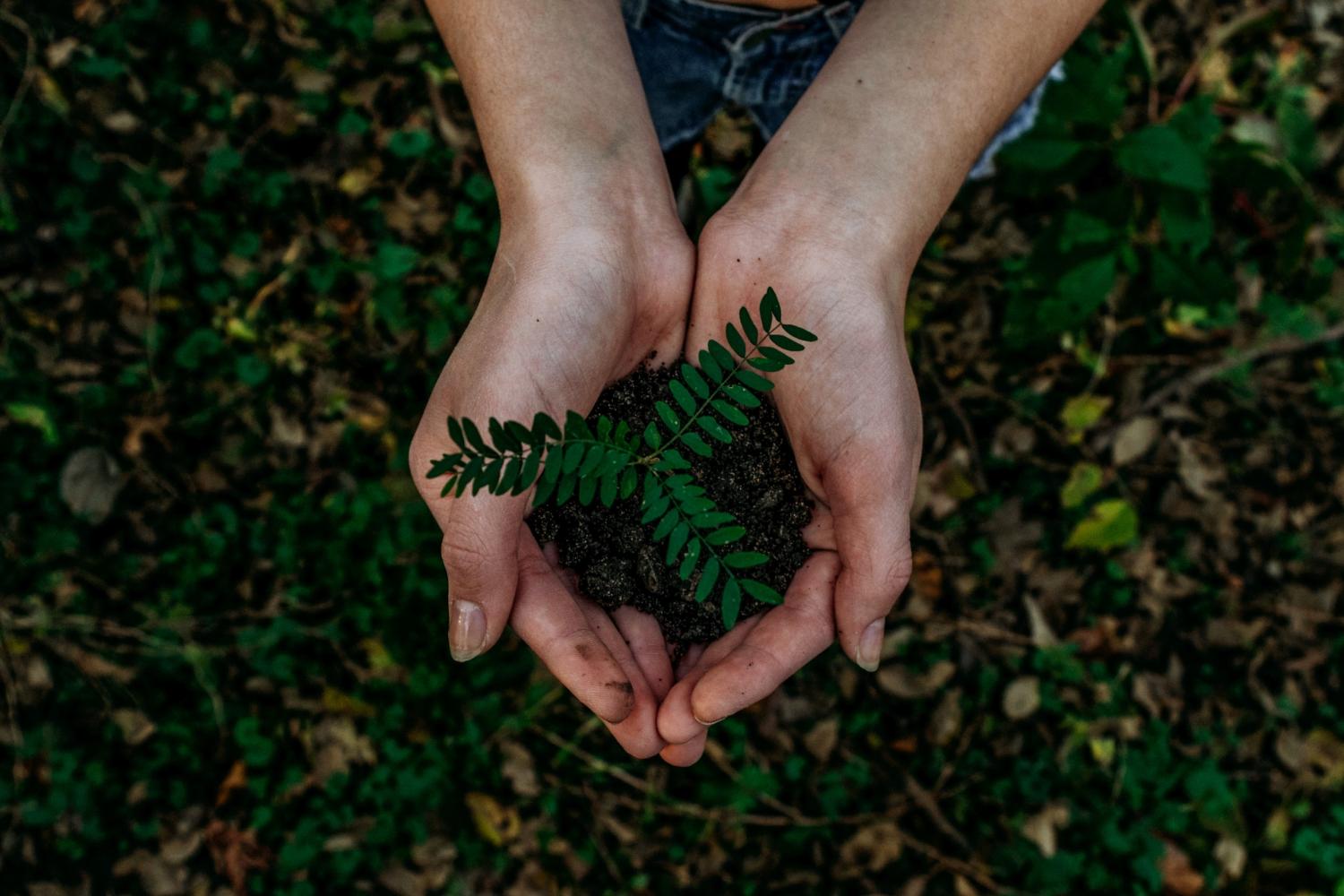
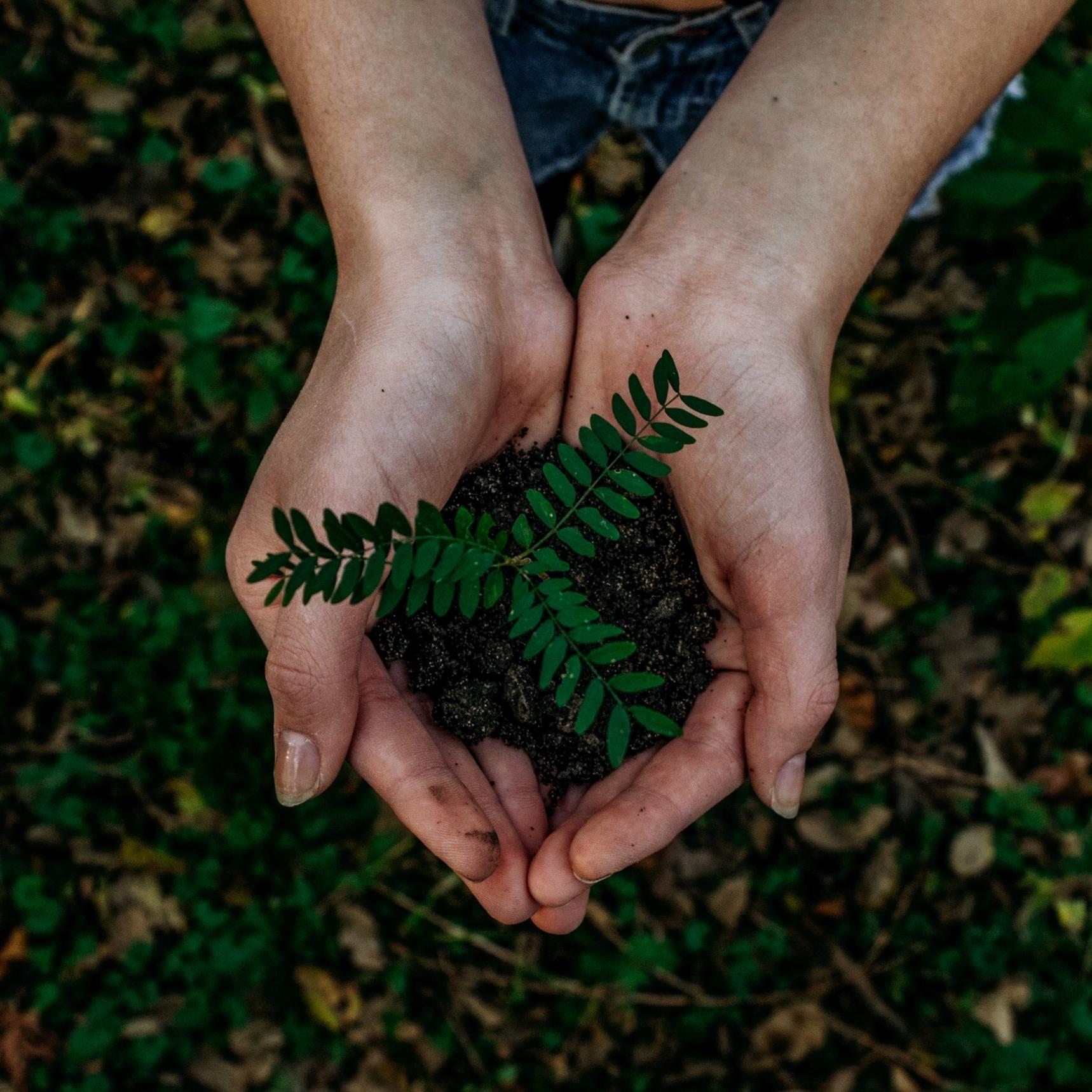
We all know that online influencers have revolutionized popular culture: Ask folks under 18 about their favorite celebrity, and they’re far more likely to name an Instagram model or YouTube personality than an actress or musician.
But can all of those makeup tutorials, prank challenges and sketch scenes shake up the way we view decidedly more serious topics like purpose and philanthropy? For YouTube sensation MrBeast, real name Jimmy Donaldson, the answer is a resounding yes.
Earlier this year, a Reddit user challenged Donaldson to do something special to celebrate reaching 20 million subscribers on YouTube: plant 20 million trees.
Donaldson—known for increasingly fantastical YouTube videos like “Paying People $10,000 To Eat Ghost Pepper”—quickly accepted. But of course, he couldn’t accomplish such a feat on his own, so he linked up with the Arbor Day Foundation to turn his fans’ eco dreams into reality.
Out of the collaboration, #TeamTrees was born. The unprecedented influencer campaign has raised more than $12 million since mid-October. Along with do-gooder YouTube fans, the campaign proved a hit with another high-profile influencer set: tech companies and their executives.
Tesla and SpaceX founder Elon Musk pledged $1 million to the campaign, bested only by Shopify CEO Tobi Lutke, who threw a touch of shade with a $1,000,001 donation. Jack Dorsey, co-founder of Twitter and fin-tech firm Square, donated $150,000. YouTube CEO Susan Wojcicki pledged $200,000, while the company committed to match $1 million in donations, Donaldson wrote in a tweet last week. And the support keeps rolling in.
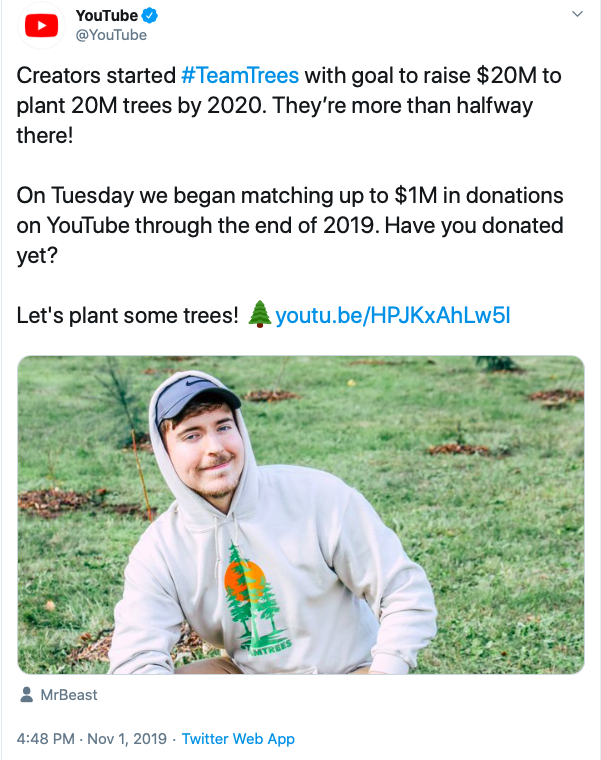
Donaldson (pictured above) and the Arbor Day Foundation have set a deadline of Jan. 1, 2020, to raise the $20 million needed to plant 20 million trees. Through its network spanning around the globe, the Foundation will plant the trees on every continent except Antarctica, from January 2020 through December 2022. Tree species will be native to each area, ensuring survivability and maximum benefit for local ecosystems, according to the campaign’s website.
The case for tree-planting to fight climate change
For many in the sustainability community, tree-planting is something of a table stakes move. It’s great and all, but with the urgency of the climate crisis and accelerating ecosystem degradation worldwide, is it really enough to match the challenges we face?
#TeamTrees doesn’t kid themselves. On its FAQ page, it willingly answers the question, “Can planting trees solve climate change?,” with a transparent: “No, not on its own.”
Still, as we’ve reported before here on TriplePundit, the world loses 18.7 million acres of forests every year, according to the WWF. Research indicates that if current deforestation levels continue, the world's rainforests may completely disappear in the next 100 years.
This is bad news for the fight against climate change. Forest restoration has the most global climate mitigation potential compared to all other natural climate solutions, according to the National Academy of Sciences. That’s because forests are natural carbon sinks: U.S. forests alone store 14 percent of all annual carbon emissions from the national economy, and restoring global forestland has the potential to contribute over a third of the total climate change mitigation scientists say is required by 2030.
Additionally, healthy forest ecosystems are critical to help communities stay resilient to natural disasters, which are increasing in severity and intensity due to climate change, Arbor Day Foundation President Dan Lambe said at the 2019 3BL Forum last week.
“The U.S. lost 8.5 million acres of forest lands due to wildfires last year alone,” Lambe said at the Forum. “The five hottest years on record were the last five years, according to NASA, and we're all seeing the increasing frequency and severity of natural disasters. All of these things are taking a toll on our forests, which are critical part of our health, wellness and resiliency.”
In response, the Foundation collaborates with governments, NGOs, community groups and corporate partners around the world on tree-planting efforts that maximize resilience to climate change.
“We're planting millions of trees, strategically with government and non-government partners, to help restore forest lands and to strategically buffer and create natural solutions to resiliency,” Lambe said. “If ever there was a time for trees, now is that time. If ever there was a time for natural solutions and leadership through conservation efforts, that time is now.”
Influencers taking stands
The 3BL Forum included a panel on the power of influencers—including eight members of the sustainerati, including our very own Leon Kaye. They spoke to the potential of leveraging millions of followers to spark positive change—and #TeamTrees presents what is perhaps the most apt example to date.
"The #TeamTrees initiative has taken off thanks to the creativity of YouTube creators who are harnessing the power, the influence and the passion of their followers," Lambe told InsideEdition. "Twenty million trees is going to make an enormous difference in helping to fight and combat climate change and other important and pressing issues all around the world."
Is viral tree-planting just the start of a new chapter in the brands taking stands story? All we can say is: We certainly hope so.
Image credit: Unsplash/Noah Buscher, Twitter/YouTube
8 Mindset Shifts To Up Your Sustainability Game, From Business Leaders Who Know
For decades, the private sector has operated under the premise of profit first. As consumers, investors, employees and other stakeholders increasingly expect business to operate with a higher purpose, many leaders are wading into uncharted waters. Navigating the sustainability seas successfully requires mindset shifts that change the way we approach our operations, supply chains and cultures. At the 2019 3BL Forum, conscious leaders shared powerful insights to help you shift your thinking and become a purpose pro.
Know your strengths—and partner to address your weaknesses
No one can be all things to all people. Every organization—from nonprofits and startups to major multinationals—has its own set of strengths and weaknesses. Your teams' unique core competencies are what make your organization great, but identifying areas where you need help—and asking for it—can help you become even better, says Dan Keim, director of humanitarian logistics for the UPS Foundation.
"Be engaged" in the way your teams function, he advised at the 3BL Forum. "Know what your organization does well, and look for others to collaborate with and partner with in those areas that you may need more support."
When you champion sustainability in the C-suite, speak in their language
"We in the sustainability community have long used our own language, buzzwords and jargon when trying to communicate internally with executives," Lawrence Heim, managing director of the conflict minerals and sustainability advisory Elm Sustainability Partners, said at the Forum. "That’s great, except for the fact that not all of the executives necessarily understand what we’re saying."
"One thing we need to do as sustainability, ESG and CSR professionals internally is talk in their language," he continued. "We need to adapt to them. We don’t need to try to force the executives to change. They will eventually, but in order to build that credibility within the organization, we have to begin the conversation with their terms."
If you're going to talk the inclusion talk, make sure you walk the inclusion walk
The seemingly endless string of offensive fashion pieces released earlier this year made it painfully clear how many brands don't have a single person of color on their design or leadership teams.
At the 3BL Forum, Leslie Short, CEO and president of the diversity and inclusion collective The Cavu Group, dug into how that's even possible in 2019 and what brands can do about it.
Short's refrain over two days at the Forum was: "Nothing about us without us," which simply means that brands—or anyone else, for that matter—shouldn't make decisions that pertain to a certain stakeholder group without consulting people from that group first. And it's not as simple as having a person at the table—even if that person is a chief D&I officer.
"Inclusion does not mean I’m sitting in that room. Have you actually spoken to me in the room? We really need to look at a company’s intent when it says that," Short said. "Everyone wants to say they have a chief diversity and inclusion officer. But what is that person doing? What is his or her purpose? Culture is not something we just speak about. It’s something you need to create."
The secret all conscious leaders know: Failure is your friend
Taking a public stance—whether it's a bold environmental goal or alignment with a social cause—can be nerve-wracking at first. Most of us fear falling short or looking silly, but really, these fears are unfounded, says Mercedes Escala, director of corporate citizenship initiatives at IBM. Your stakeholders, particularly your employees, know your company isn't perfect—and they're more likely to respect you if you aim high and fall short than if you sit on your hands and do nothing.
"It's okay to try something that ultimately doesn’t work," Escala said this week. "As our employees see us being willing to fail and to iterate, they're even more likely to amplify in our voice and believe in us because they feel proud of what we are all doing."
Invite people to be a part of your purpose activations
We heard consistently at the Forum that today's consumers and employees, particularly young people, don't just want to read about your social or environmental stance—they want to be a part of it.
"If you’re talking about an issue, it’s important to not only talk about what it means to your company, but also how it affects other people and why the company is addressing the issue," said Wesley Gee, director of sustainability for the Works Design Communications. "And the even better way of doing it is to bring other people into the fold and make them a part of that discussion rather than the perception of companies beating their chests."
Vulnerability is a good thing
As Nandika Madgavkar, senior director of CECP's Strategic Investor Initiative, said at the Forum: "If companies don’t tell their story, someone else will tell it for them—and it’s not going to be pretty."
Cecily Joseph, who spent over a decade leading corporate responsibility and D&I efforts at Symantec before becoming chair of the youth mobilization nonprofit Net Impact, elaborates: "I encourage everyone to tell your company’s story and to do it from a place of feeling vulnerable and striving for continuous improvement," she said at the Forum.
"I have been through 11 years of corporate responsibility reporting and setting goals, and it can be very challenging when you feel you don’t have it all together yet. But that’s okay. That road we’re all on toward trying to be honest and trying to tell our story is very important."
To gain buy-in from the uninitiated, lead with the ROI
Like many multinationals, Ascena Retail Group, the parent company behind brands like Ann Taylor, Loft and Lane Bryant, focuses much of its responsibility work on its supply chain. As part of its work, the company committed to empower 100,000 women in its global supply chain with health or financial literacy training in partnership with BSR's HERproject.
There are clear social benefits that come with this, but focusing on the financials is what really inspired suppliers to jump on board, says Jeannette Ferran Astorga, vice president of corporate responsibility for Ascena.
"Find the ROI," she advised other business leaders. "In our story, we lean heavily on our partners to drive impact—and that influence is important—but there’s no better way to influence than by showing the ROI. We were quickly able to prove to our suppliers that there is a return on investment from creating space in your workplace to empower women with more education—higher productivity, lower turnover, higher retention, lower absenteeism. It’s a win-win-win for the business, for the women and for the supplier."
Cut yourself—and your peers—a little slack
As the saying goes, "Don't let the perfect be the enemy of the good." Some might call this a cop-out, but the truth is that adopting change in massive institutions such as multinational companies takes time. By criticizing those who don't have it all figured out yet, we essentially discourage them from trying—and that's the opposite of what we in the sustainability community really want, says Kari Niedfeldt-Thomas, managing director of corporate leadership at CECP.
"The reality is there are some of us that are leading a little firmer than others," she said at the Forum. "They’re a little clearer about their direction. But that doesn’t mean that those who are just starting on their journey or who are maybe making some attempts at a journey should be criticized for even attempting. Part of the concept of inclusion is to open the door and welcome everyone—and that means that everyone has to be able to get started."
Carbon Capture Could Do More Harm Than Good, Researchers Say
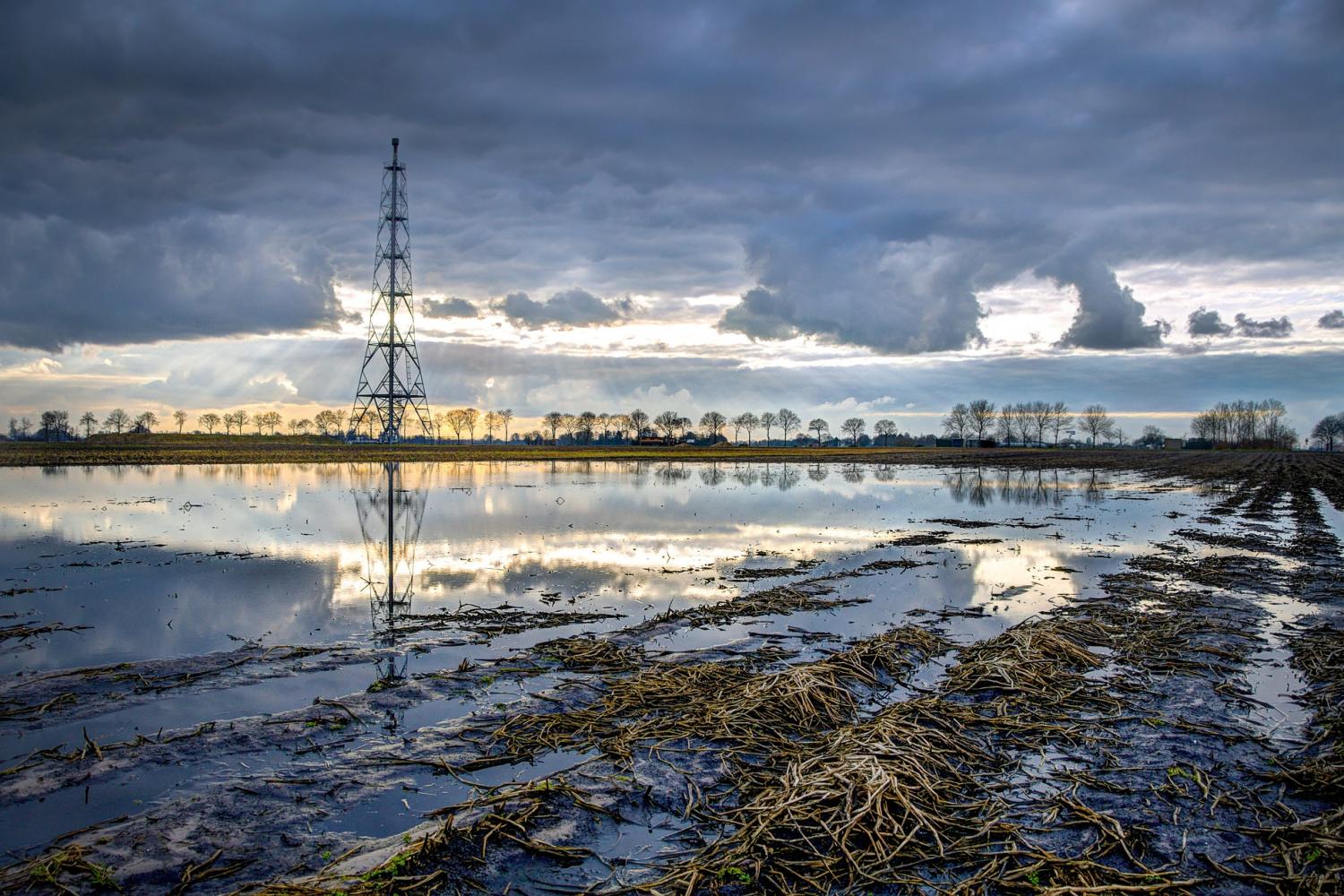
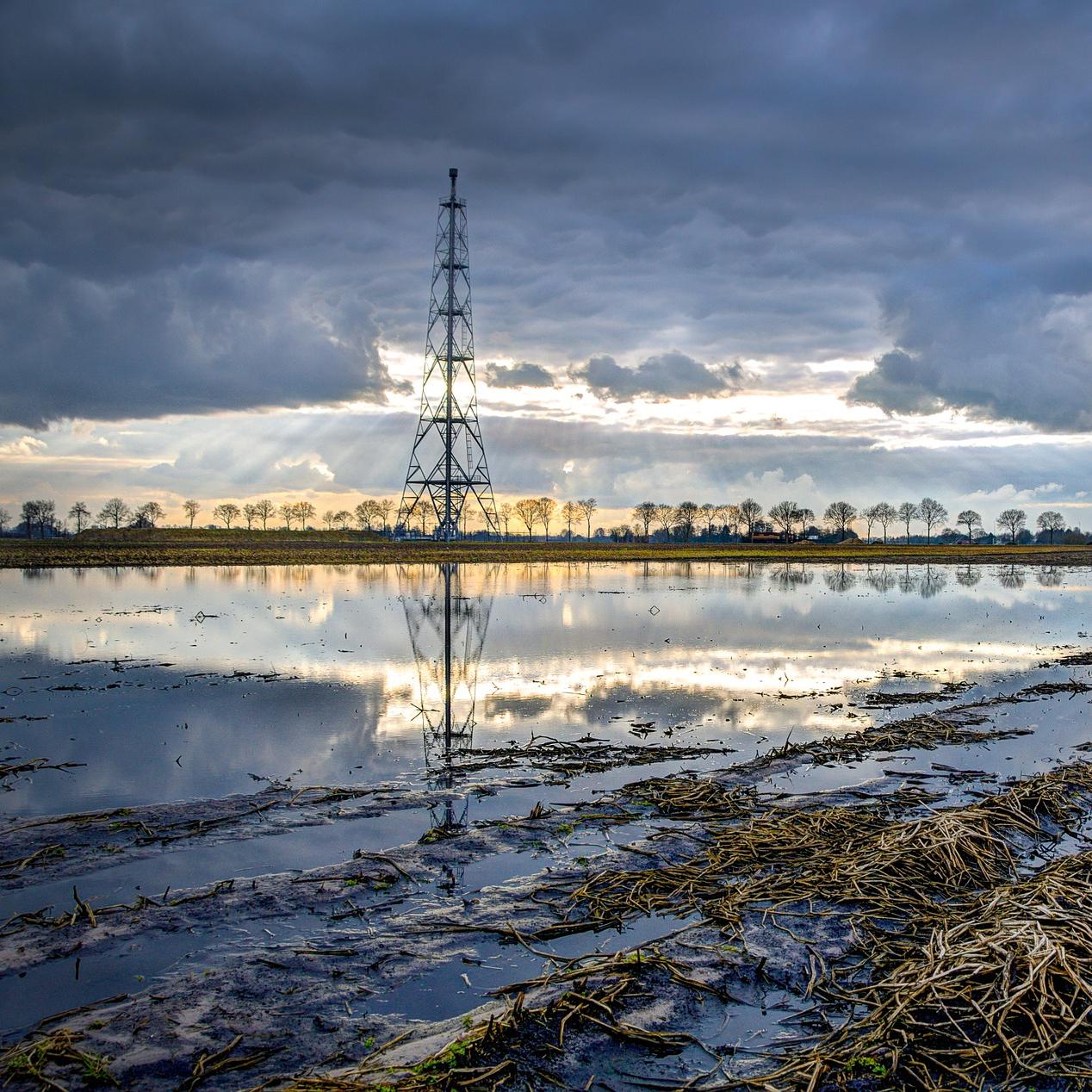
(Image: The natural gas life cycle is just one factor cited by researchers who cast doubt on the efficacy of carbon capture at energy facilities.)
Carbon capture has been touted as an effective way to reduce emissions on a global scale, and that has attracted the eye of investors looking for innovative opportunities to boost their green cred. However, the proof is in the pudding. Evidence is mounting that carbon capture is becoming irrelevant—and may even do more harm than good—when renewable energy is already at hand.
Carbon capture once made sense…
Not too long ago, carbon capture was actually a pretty sensible solution for emissions from power plants, at least from an economic perspective. Renewable energy was expensive, and the global fleet of coal power plants seemed to be on a path of all but certain growth.
More recently, low-cost wind and solar have combined with energy storage, energy efficiency, and smart-grid technology to beat coal at its own game.
Here in the U.S., coal power plants are already falling like dominoes. Low-cost renewables are also beginning to threaten coal’s main competitor, natural gas.
In addition, the clean tech supply chain, workforce, and financial pipeline are all growing and maturing. That has created the conditions for the renewable energy transition to accelerate.
The natural gas angle
Into this scenario steps new research from Mark Z. Jacobson, professor of civil and environmental engineering at Stanford University.
Published this month in the journal Energy and Environmental Science, of the Royal Society of Chemistry, Jacobson’s study looks at the publicly disclosed emissions from a coal power plant equipped with a carbon capture system. The study also covers public data from a plant that captures carbon from the ambient air.
At both of the plants, the carbon capture systems were run on electricity, generated by natural gas.
Methane emissions and electricity
That should set off red flags right there. Gas produces less pollution when burned than coal, but the burning comes at the tail end of a long “upstream” chain of methane emissions.
Methane is the primary component of natural gas, and it is a powerful greenhouse gas. Methane escapes from multiple points in the supply chain, including drilling operations at natural gas fields, transportation pipelines, storage facilities and distribution networks.
That is exactly what Jacobson takes into account. His study compares the savings in carbon emissions at both plants with the upstream emissions related to natural gas supply, as well as “downstream” emissions from the coal power plant and emissions relating to gas-sourced electricity.
The results are striking. According to Stanford, typical studies of carbon capture technology are based only on downstream emissions. By including upstream emissions, Jacobson arrived at a 20-year average carbon capture rate of approximately 10 percent.
That’s a far cry from the impressive rate of 85 to 90 percent claimed by carbon capture stakeholders.
The social costs of carbon capture
Jacobson’s study also took social costs into consideration, including “air pollution, potential health problems, economic costs and overall contributions to climate change.”
These upstream impacts are critical, but until now they have played little part in the carbon capture economy.
Nevertheless, both coal mining and natural gas drilling have been well established as leading sources of public health hazards and economic malaise in local communities.
“Even if you have 100 percent capture from the capture equipment, it is still worse, from a social cost perspective, than replacing a coal or gas plant with a wind farm because carbon capture never reduces air pollution and always has a capture equipment cost,” Jacobson argues.
Of course, carbon capture, biogas recovery and other air pollution controls will continue to play a growing role in reducing greenhouse gas emissions from other industrial operations, including agriculture.
For now, though, carbon capture for electricity generation is a no go, at least here in the U.S.
The U.S. Department of Energy is still funding carbon capture research. However, the agency’s lone showcase carbon capture project, the $1 billion FutureGen facility, stalled out back in 2015 and is permanently mothballed.
It appears that U.S. policymakers have already looked at the same math as Jacobson and reached a similar conclusion.
Image credit: Pixabay
This Unlikely Partnership Drives Positive Change in the Food Sector
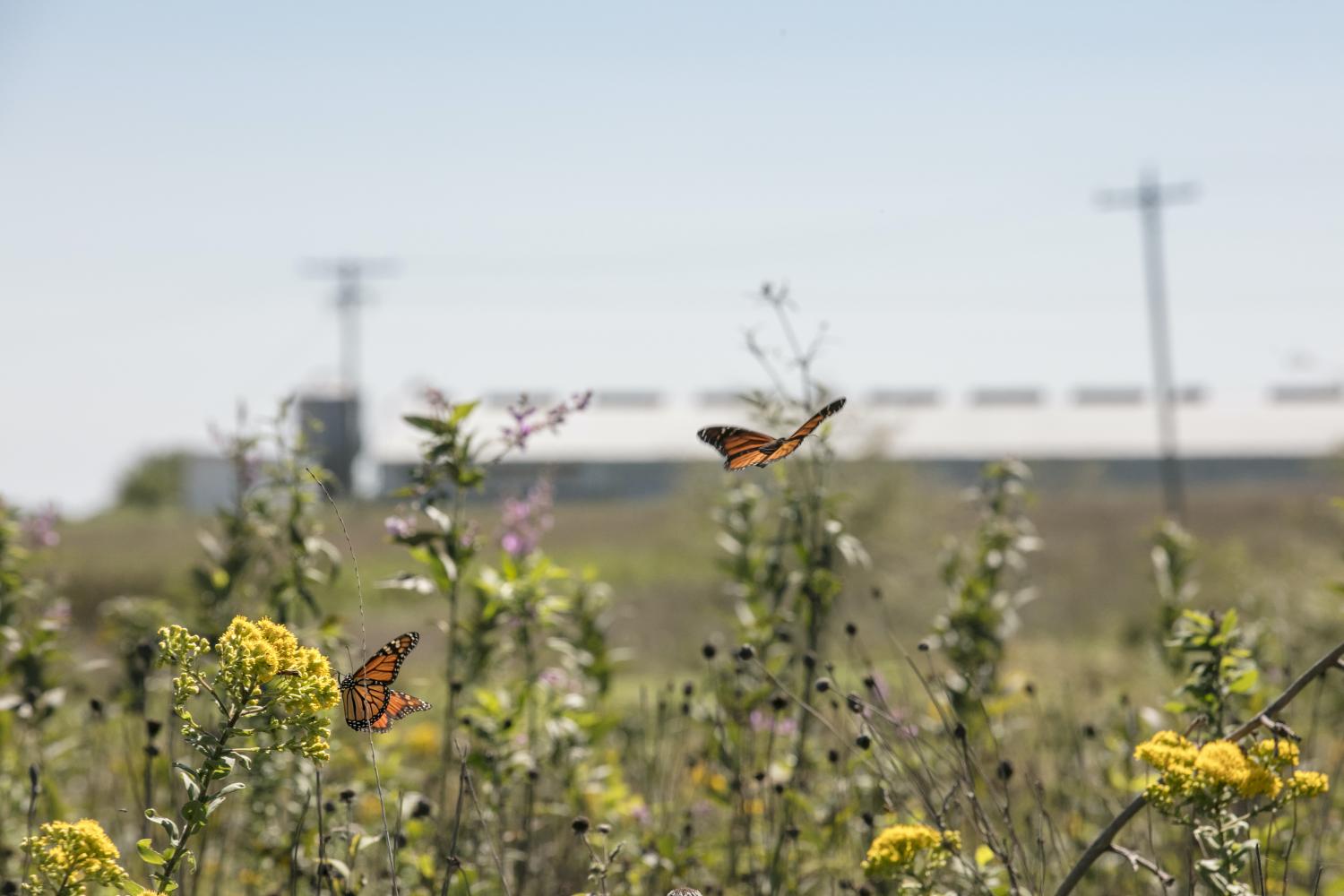
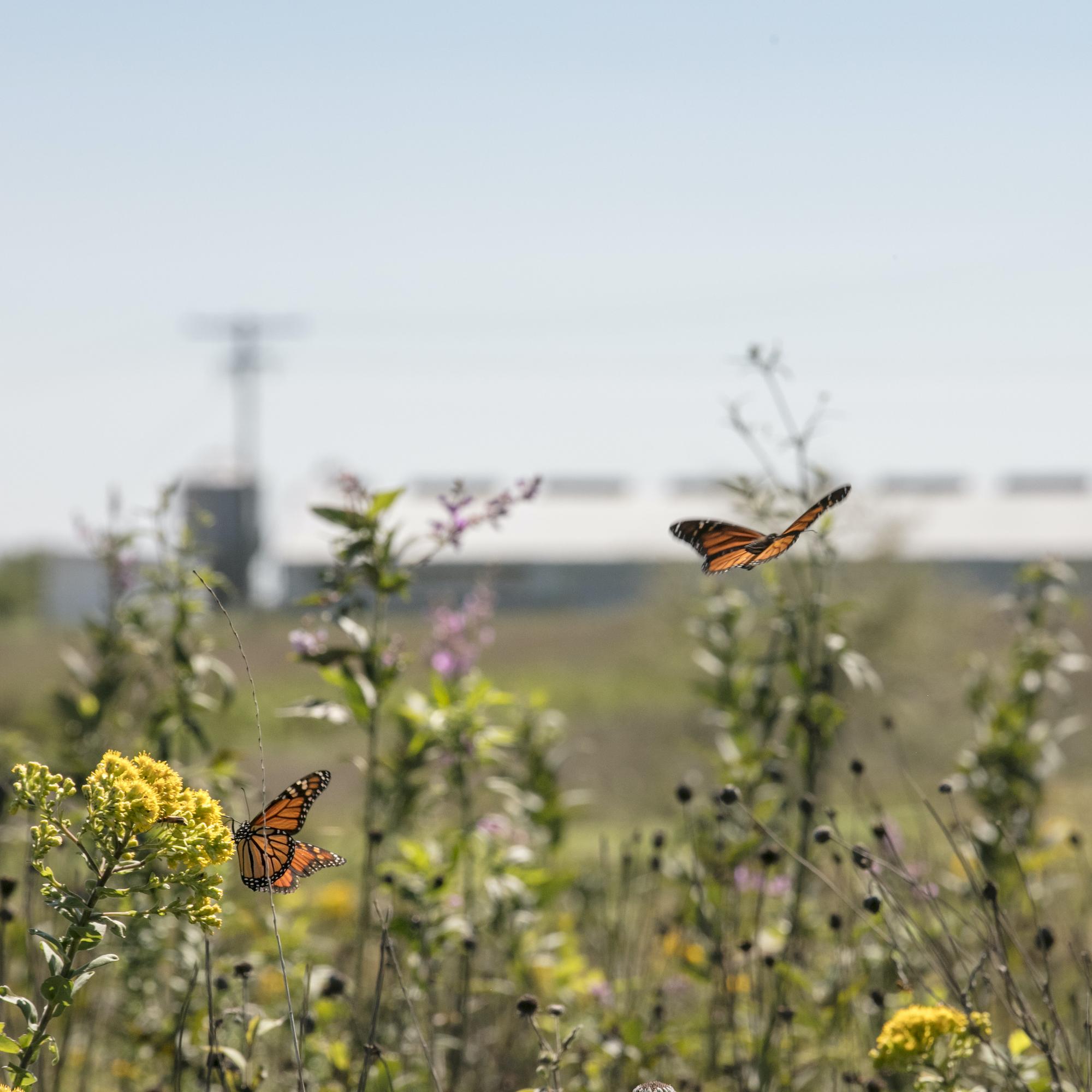
(Image: A biogas capture project on a Missouri hog farm—which helps restore native prairies and monarch butterfly habitat—is just one part of Smithfield Foods' unlikely partnership with Environmental Defense Fund.)
It is imperative that farmers, food companies, policymakers, and environmental advocates collaborate to figure out how to feed a growing global population while minimizing environmental impacts and building a more resilient food system. One company that is stepping up to this challenge is Smithfield Foods.
Over the past six years, Environmental Defense Fund (EDF) has been working with the global food company, which is also the world’s largest pork processor and hog producer, to reduce greenhouse gas (GHG) emissions and environmental impacts from its operations and across its supply chain. And last week, Smithfield president and CEO Ken Sullivan and I were both at the Bloomberg Sustainable Business Summit in New York City to talk about our work together and how partnerships can accelerate environmental results.
The common themes in our collaboration are an ambitious goal and a focus on solutions that generate shared value for the environment, farmers and the bottom line. That shared value creates lasting commitment to sustainable agricultural practices and can serve as a model for other business leaders seeking to address the growing demand for climate action from investors, consumers and the next generation.
Here are two key ways Smithfield is raising the bar for corporate sustainability leadership—and proving what’s possible for other food companies.
Commitment to big, hairy sustainability goals
Based on nearly 30 years of forging unexpected partnerships with high impact companies, I’ve seen firsthand how setting big goals can unlock innovation and big results for the environment.
Our collaboration with Smithfield began when our mutual partner, Walmart, engaged its suppliers in reducing GHG emissions in its supply chain. Smithfield stepped forward to become the first major animal agriculture company to address the environmental footprint of the grain it grows for animal feed, by setting a goal to implement climate-smart agriculture practices on 75 percent of its grain acreage. (Animals consume nearly 40 percent of all corn grown in the U.S., so companies like Smithfield can play a critical role in ensuring that grain is grown as sustainably as possible.)
Through its work with EDF, Smithfield built a grain sustainability program that enabled the company to surpass this goal in 2018, hitting 80 percent of its grain acreage, the equivalent of more than half a million acres. Smithfield’s ongoing sustainability efforts continue to support farmers in implementing these practices, which include diversifying their crop rotations, growing cover crops, and optimizing fertilizer applications.
Reaching this milestone highlighted the company’s appetite for sustainability leadership and revealed new business opportunities for the company and its farmers.
In 2015, EDF challenged Smithfield to “think big” when the company committed to setting a new sustainability goal. And Smithfield seized the opportunity to lead the livestock industry by following with a commitment to reduce absolute GHG emissions 25 percent by 2025 across its supply chain, from feed grain to packaged bacon. This ambitious goal has the potential to reduce emissions by more than 4 million metric tons, the equivalent of removing 900,000 cars from the road.
And just last year, Smithfield committed to installing manure lagoon covers and digesters on the majority of its company-owned and contract hog finishing farms in four states over the next 10 years. The new technology can capture approximately 85,000 metric tons of the potent GHG methane each year and turn it into biogas.
Collaborating for scale
Ambitious climate commitments cannot be achieved alone. Only by working together can we accelerate environmental progress across global supply chains with the scale and speed required. Smithfield’s GHG goal is no different: It requires collaboration within different divisions of the company, across its own supply chain, and with diverse partners outside of the company.
Smithfield’s partnership with EDF is the first such example: While we don’t agree on everything, we have found substantial common ground in developing Smithfield’s sustainability goals and initiatives. One of our focus areas has been identifying tools and practices that reduce environmental impacts while generating benefits for farmers.
These programs also benefit Smithfield: By building relationships with local grain growers, Smithfield increased the proportion of grain it buys directly from farmers from less than 10 percent to more than 60 percent in just 10 years, saving $8 million in grain purchasing costs in 2018 alone.
Smithfield and EDF also collaborated with the University of Minnesota’s NorthStar Institute for Sustainable Enterprise to develop a detailed GHG footprint for the company. The analysis created a map of emissions “hotspots” that guides Smithfield toward the highest-impact opportunities to reduce emissions. And the company is partnering with Dominion Energy to deliver on its commitment to install manure lagoon covers and digesters.
Smithfield and EDF are also working with Roeslein Alternative Energy to capture biogas on the company’s Missouri hog farms. This collaboration presented an unexpected opportunity to restore native prairies and monarch butterfly habitat. To multiply the benefits of the initiative, the prairie grasses can be harvested and used as additional fodder for biogas generation.
It will take more collaborations like these at scale, from within and across industries and supply chains, to bring about the transformational changes we need to create a world where business and the environment can thrive in unison.
The future of sustainability partnerships
As we look to the future, EDF will continue to work with Smithfield and other major companies to identify new ways to accelerate the transition to a 100 percent clean economy. Forward-thinking companies are investing in Fourth Wave technologies like sensors and data analytics to supercharge business and sustainability. EDF is also collaborating with business leaders to make their voices heard in the halls of government to influence smart climate and environmental policy.
When companies take the leap to embrace ambitious goals and new partners, environmental and business benefits follow.
American Express Relaunched the Green Card—And It's Greener Than the Original


American Express relaunched its classic Green Card last week. The color represents more than 50 years of serving customers, and the card itself marks an environmental first for the company.
Renamed Green from Amex, it's the first American Express card manufactured primarily from plastic recovered from oceans and coasts.
“Through our materiality process, we found we were vulnerable by our use of paper and having cards made out of plastic,” Tim McClimon, president of the American Express Foundation and senior vice president at American Express, said at the 3BL Forum this week. “So, we did something about it.”
American Express will source the plastic in partnership with Parley for the Oceans, a collaborative of organizations and individuals working to protect the world’s oceans.
“American Express is creating a symbol of change and inviting their network to shape a blue future, one based on creativity, collaboration and eco-innovation,” Cyrill Gutsch, founder of Parley for the Oceans, said in a press statement.
As part of its work with Parley, American Express has committed to remove up to 1 million pounds of marine plastic pollution. To help, in September, the company and Parley kicked off a global call-to-action rallying card members, merchants and employees to take to Instagram and explain why they #BackOurOceans. For every comment received during this time, American Express and Parley committed to remove two pounds of plastic from beaches and coasts.
McClimon also shared that Green from Amex will be recyclable. Starting in 2020, U.S. consumer, small business and corporate card members can send their expired or non-working cards back to American Express, which will work with a vendor to remove the metallic chip and protect consumers’ information while recycling the plastic.
Another new card feature allows customers to redeem their reward points on products that help reduce plastic waste in their daily lives, including stainless steel water bottles and straws, beverage mugs, and reusable food bags.
“We hope Green from Amex will serve as a daily reminder to our card members to do their part to back our oceans and consider how they can reduce the use of plastic in their own lives,” Rachel Stocks, executive vice president of global premium products and benefits at American Express, said in a press statement announcing the new card.
The relaunched card is all part of the company’s broader commitment to eliminate single use-plastics across its operations by 2025. To date, it has replaced all single-use plastics in its cafeteria with compostable packaging and utensils, eliminating 62,000 pounds of single-use plastic, according to the company. It also removed plastic straws and coffee stirrers from its global headquarters, managed office facilities and operating centers.
Credit card holders have more ways to be green
American Express is not the only financial services company thinking more broadly about how it can reduce its environmental impact.
Mastercard recently became the first in the sector to set a science-based emissions target, which ensures that its actions help the world meet the goals outlined in the Paris climate agreement.
Meanwhile, Visa offers several credit cards aligned with the environment. The Green America Visa supports the nonprofit Green America's programs that work to advance clean energy and support green businesses. With the Amazon Watch Visa, card holders can help Amazon Watch in its work with indigenous communities and at the regional and international levels to protect ecologically and culturally sensitive ecosystems in Brazil, Colombia, Ecuador and Peru.
We also heard at 3BL Forum this week that consumes want to join with companies who value the same issues they do. American Express and others in the sector are giving them just the opportunity.
Image credit: American Express via Business Wire
Why Should Brands Take Stands? Business Leaders Weigh In
(Image: Storied management strategist Mona Amodeo (left) and other thought leaders discuss why brands take stands at the 2019 3BL Forum.)
Gone are the days when companies and their executives can stay silent about the defining issues of the day. Nearly two-thirds of global consumers want companies to take a stand on social issues, and 56 percent say they have “no respect” for CEOs who stay silent, according to research from Edelman.
The shift in public expectations is clear. Still, after decades of staying out of the fray for fear of offending potential customers, many in the business world are unsure of how and when to make their voices heard.
At the 2019 3BL Forum, more than 90 speakers on the main stage—from executives of major multinationals, to founders of purpose-driven startups, to researchers well-versed in the latest consumer trends—shared valuable insights that can help chart the way forward.
Together, they looked to answer two simple yet loaded questions: What’s next in the brands taking stands movement—and, more importantly, why should companies get involved? Read on for the need-to-know insights shared on day two of the Forum, held at MGM National Harbor, just outside Washington, D.C.
To be effective, executives need a purpose beyond profit
According to Edelman's data, 84 percent of people now expect CEOs to "inform conversations and policy debates" on pressing societal issues. In order to do this successfully, they must first understand why their companies exist beyond the bottom line, says Mona Amodeo, founder of the brand transformation firm idgroup and author of “Beyond Sizzle: The Next Evolution of Branding.”
"Organizations must believe they have a deep social contract with society, and that’s not something that you wake up one morning and decide," she said at the 3BL Forum. "It’s really an internal truth. It’s about looking deep inside one’s self and asking: What do I believe my company’s responsibility is? What do we give, and what do we take? And with that comes the ability, as a leader, to be an advocate and a storyteller about the core values of an organization—to talk about it, to preach about it, to believe in it and to engage others in it."
Today's employees want action, not words
How many times have you heard business leaders squabble about what to call their purpose activations? Are they ESG? CSR? Sustainability? Put all of those annoying think pieces aside, because really, the semantics don't matter—and even further, they can hold you back, says Barie Carmichael, senior advisor of the strategic communications consultancy APCO Worldwide.
"Sometimes definitions get in the way of actual actions," she said on Wednesday. "People are so worried about whether it’s an S or a G or an E. At the end of the day, the authentic content for a company are its actions—not its pledges. What you do is the proof, particularly for the younger generation. And the people who will call you on it if you get it wrong are largely your own employees."
Trusted companies will "win the talent war"
In today's tight labor market, the battle is on to recruit, retain and engage top talent—and the brands that are willing to get real will be the ones to win the day, says Bryan de Lottinvile, founder and CEO of the corporate responsibility and employee engagement software provider Benevity.
"The trust piece is both an opportunity and an expectation, which we often call a 'problem-tunity.' But the companies that get it right and have an authentic program that is inclusive and a culture that is compelling to the diverse demographics in the workforce, they will win," de Lottinvile said. "They will win the talent war. They will win the brand war, both with employees and consumers. And our data is proving that out."
Young people want to see brands take stands—and they want to get involved
Meredith Ferguson and DoSomething Strategic, the social impact consulting arm of DoSomething.org, have their fingers on the pulse of the younger generation, what they're looking for and what engages them. We already know these young people prefer brands that take stands, but that's only the beginning—what they really crave is a way to get involved. "What young people are looking for is to be a part," said Ferguson, managing director of DoSomething Strategic and one of the most powerful voices for youth and social impact.
"So many business people think they have to push out what they stand for and their cause platform. And yes, you should absolutely do that—you need to talk about it consistently and everywhere. But the easiest way to make an impact on a consumer and an employee is to invite them to be a part," she continued. "They’re few and far between right now, but brands that do this are building a loyalty based on shared values—not on price point, not on new product releases, just on shared values. And what an opportunity that presents to build a community of like-minded individuals who will be loyal for the long term."
A new age of accountability is coming
If you think it's hard to hide from criticism now, you're in for a rude awakening in the near future, says Peter Kozodoy, author of the forthcoming book, “Honest to Greatness: How Today’s Greatest Leaders Use Brutal Honesty to Achieve Massive Success.”
"Do we all really think we’re not going to approach a time when we can ask Siri, 'Is that CEO full of sh*t?'" he asked rhetorically, to a chorus of laughter, on day two of the Forum. "The last thing I want to see is a company showing me their sustainability report. That’s great, but so what? Carrying honesty throughout the organization, not just in a sustainability report, will create a company that smashes the competition in their industry."
Investors want to know about your environmental, social and governance (ESG) data... seriously
For decades, most companies assumed that investors, customers and other stakeholders weren't interested in ESG. And for most of that time, they were probably right. But no longer, says Megan Fielding, senior director of responsible investing for U.S. asset manager Nuveen.
"ESG matters. It matters to investors. It matters to your stakeholders. It matters to all of us," she said at the 3BL Forum. "Years ago, it had this reputation of being a nice-to-have. Or companies reframed content they already had and created a template to share with investors and check the box, saying they had ESG information available. But today, it really matters. It’s financially material to your company and to the work you do. And from an investor’s perspective, it's a critical component of how we’re evaluating companies when we purchase for the long term."
In case you missed it: Click here to follow our coverage of the 2019 3BL Forum: Brands Taking Stands—What's Next.
3BL Forum: New Report Shows Gen Z Is Ready to Change the World
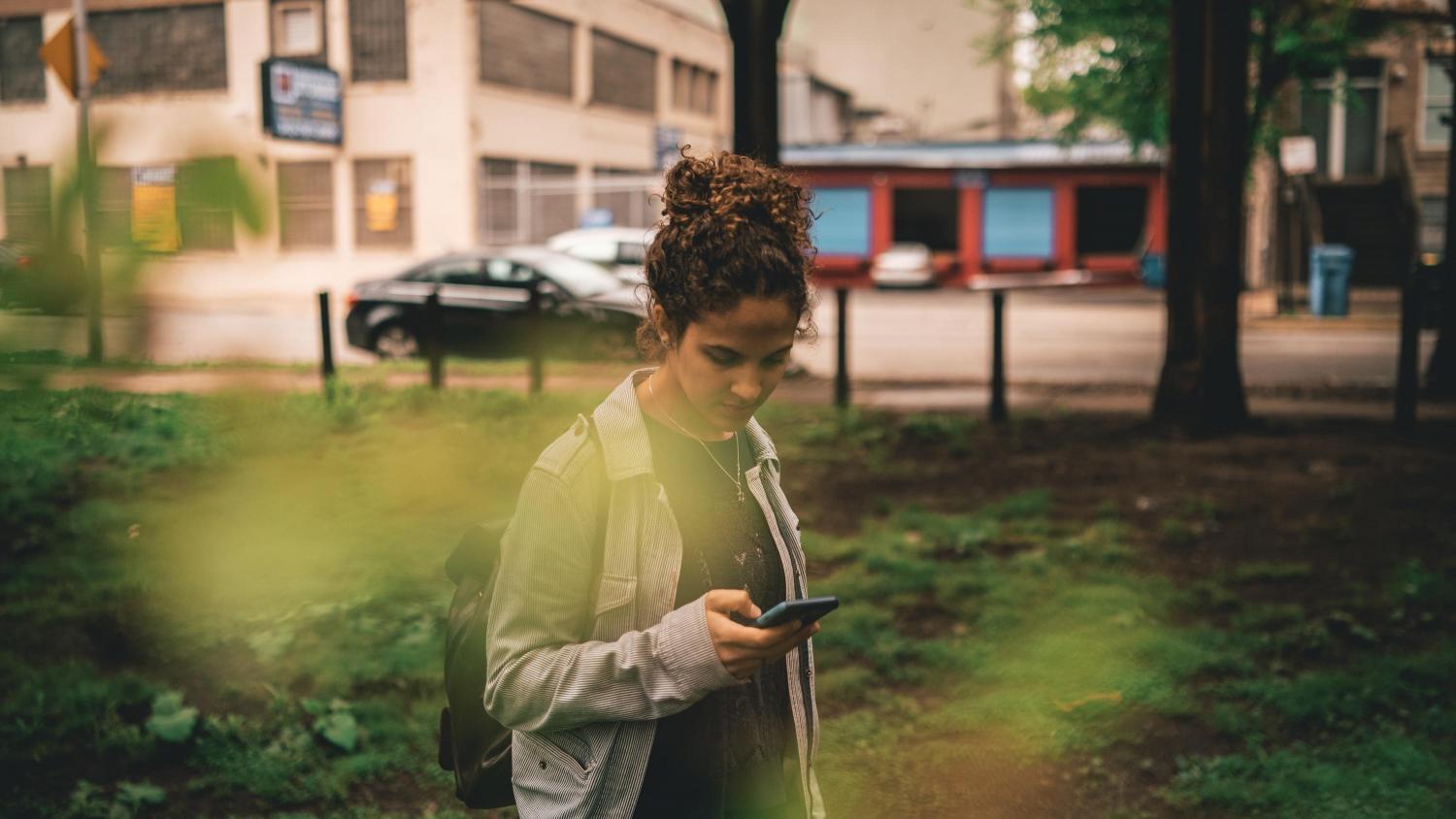

Watch out, Gen Xers and millennials. Generation Z is ready to change the world.
According to the 2019 Porter Novelli/Cone Gen Z Purpose Study, discussed at this week’s 3BL Forum, Gen Zers believe they are the key to pushing forward on the world’s top social and environmental issues, from climate change to gun control.
The study, surveying Americans ages 14 to 22, examined this emerging generation’s expectations of and attitudes toward company involvement in social and environmental issues—and the actions they are willing to take to positively impact topics they care about.
Nearly 90 percent of Gen Zers are worried about the environment and the planet, while the same amount are inspired when their peers like Emma González and Greta Thunberg take stands on issues, Whitney Dailey, vice president of marketing, research and insights at Porter Novelli/Cone, shared during the Forum.
Gen Z wants to align with purpose-driven companies
While Gen Zers feel personally responsible to make a difference, the vast majority (90 percent) also believe companies must take action to help social and environmental issues. In fact, more than 90 percent say if a company makes a commitment, it should have the appropriate programs and policies in place to back up that commitment. And there’s no hiding from these digital natives: Three-quarters say they’ll do research to see if a company is being honest when it takes a stand. (Purpose-washers, beware!)
Companies that demonstrate authentic purpose to this astute demographic will be rewarded, as Gen Zers use purpose as a core filter in deciding which companies to associate with, Dailey said. The reports data suggest that 83 percent consider a company’s purpose when deciding where to work, and nearly three-quarters factor in a company’s purpose when shopping.
“In the ever-increasing war for budding talent, companies must understand that purpose is a strong filter for Generation Z,” Alison DaSilva, executive vice president of purpose and CSR for Porter Novelli/Cone, told the 300-plus attendees at 3BL Forum this week. “Gen Zers are not willing to check their values at the workplace door, so companies need to clearly communicate how they are making an impact to appeal to this driven but discerning generation.”
Gen Zers are also willing to roll up their sleeves and participate. Around three-quarters stand ready to support companies that care in a variety of ways, including: sharing their positive opinion about a company doing good (85 percent), buying a product with a social or environmental benefit (84 percent) and learning what they can do to make a difference (also 84 percent).
Timberland campaign seeks engagement with Gen Z
Timberland is one company counting on Gen Z to help it change the world. The outdoor outfitter recently launched its Nature Needs Heroes campaign to inspire a greening movement among consumers.
“Our heroes are a community of open-minded and multi-generational ‘changemakers,’ people who devote their talents to making a difference, committed together to building a better future for the environment and the people who live in it," the company explains on its website. "We’ll lead this charge with action and doing, not just talk.”
“The campaign is a call-to-action to engage people in small, everyday actions that make a difference and help forward a greener world,” Atlanta McIlwraith, senior manager of community engagement and communication at Timberland, shared during 3BL Forum. "The small actions add up, and as many people do small actions, you get a movement—and it is movements that change the world."
McIlwraith believes that Gen Zers want companies to market with them, not at them.
Timberland’s campaign allows consumers to join in through interactive booths in high-traffic urban centers. Once inside, consumes can learn about the campaign and make a pledge on how they will live life a little greener. The company is also hosting outdoor service events throughout the United States where its “heroes”—such as musician Loyle Carner, author and YouTube host Summer Rayne Oakes, and urban gardener Keven Espiritu—join Timberland employees and consumers to revitalize green spaces.
“We are finding that [Gen Zers] are really excited to learn about what we are doing to support the environment; this resonates with them,” said McIlwraith, who sees Gen Zers sharing information about the events and eco tips from the campaign’s website with their own networks.
Perhaps Gen Z’s involvement and passion about taking action to save the environment is not surprising. After all, some are even calling for Generation Z to be renamed “Generation GND,” an homage to the youth activists’ commitment to making the Green New Deal a reality.
“People call my generation ‘Generation Z,’ as if we are the last generation, but we are not,” teen climate activist Jamie Margolin said in a hearing before the House Committee on Foreign Affairs and Select Committee on the Climate Crisis in August.
And that is good to hear.
Image credit: David Sager/Unsplash
Loop CEO: Zero-Waste Shopping Service Continues to Grow
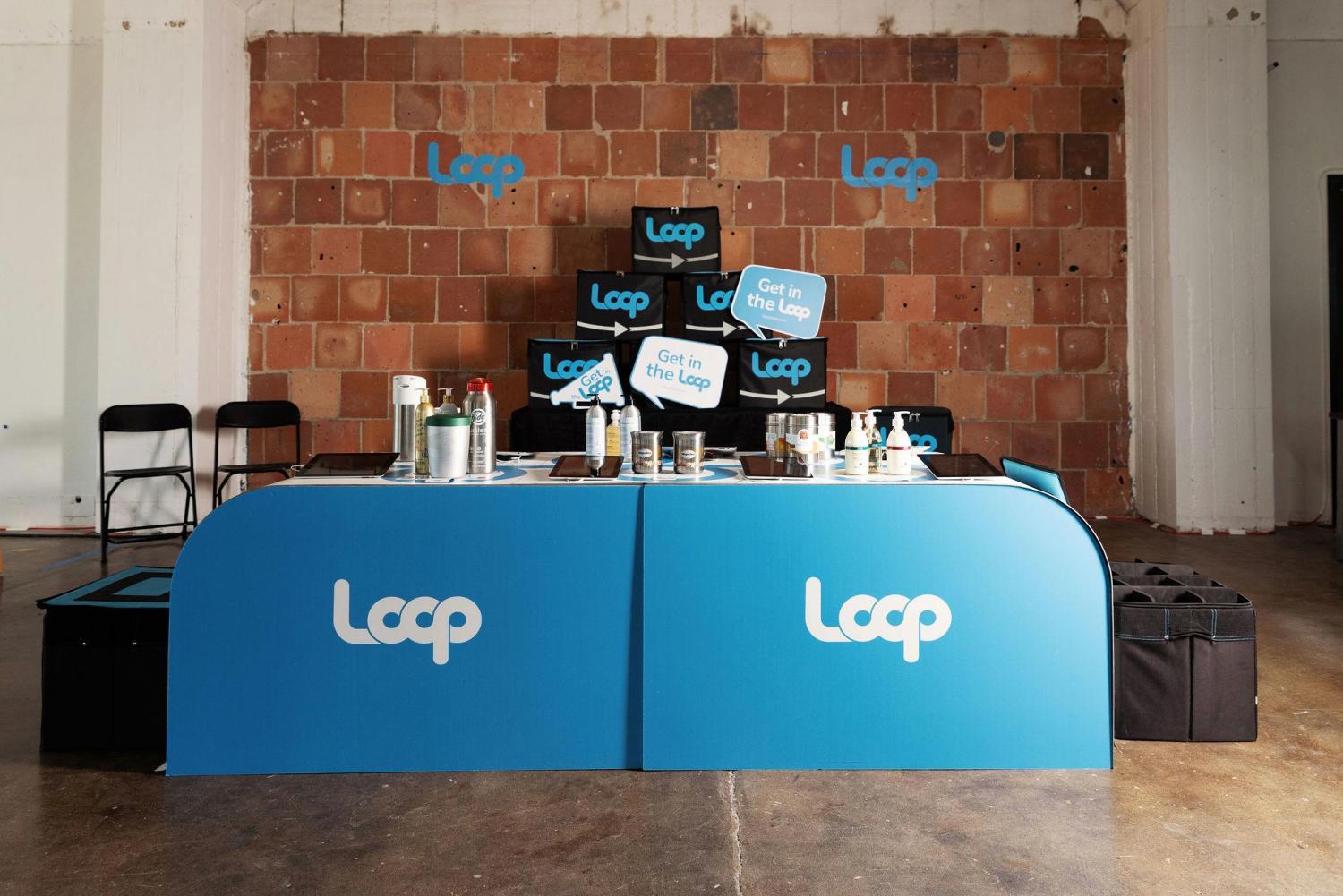
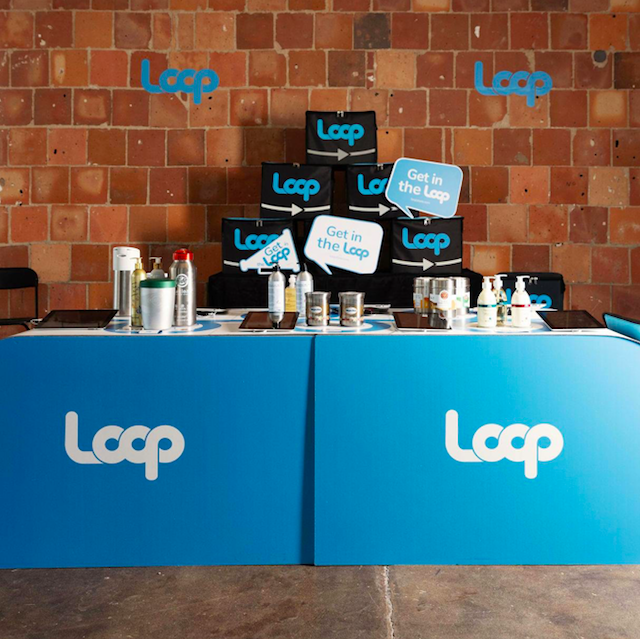
It’s been nine months since the startup Loop, brainchild of TerraCycle founder and CEO Tom Szaky, took the world by storm with its zero-waste circular delivery service. If you’re like us at TriplePundit, you’re probably wondering how it is doing as it nears the one-year mark.
While the company does not disclose its total number of subscribers, Szaky gave a candid update at last week’s Bloomberg Sustainable Business Summit in New York.
Adding one brand per day
First announced at the World Economic Forum in January, Loop made its initial start with pilots in metro New York and Paris. Ever since, Szaky says, business has been quickly growing.
Today, Loop is available in select areas in New Jersey, New York, Pennsylvania, Delaware, Vermont, Connecticut, Rhode Island, Massachusetts, Maryland and Washington, D.C. It is in the process of expanding throughout the United States, as well as the United Kingdom, Canada, Germany and Japan, Szaky said. And with comments such as “When is Loop coming to Illinois….I can’t wait!” sprinkled across Loop’s Instagram account, it seems expansion can’t come soon enough for many.
Loop’s value proposition is enabling the consumer “to responsibly consume a variety of commonly used products from leading consumer brands in customized, brand-specific durable packaging delivered in a specially designed reusable shipping tote.” When finished with the product, the packaging is collected, cleaned, refilled and reused. There are no monthly membership fees or subscriptions, although customers do pay a refundable one-time deposit to borrow the reusable container.
“Loop will not just eliminate the idea of packaging waste, but greatly improve the product experience and shopping convenience,” Szaky said at the launch.
The initial coalition included 28 partners such as Procter & Gamble, Unilever, PepsiCo, Mondelez International, Nestlé, Danone and UPS. Today, the list has grown to 42 partners selling brands such as Häagen-Dazs, Tide, Tropicana and Colgate.
Essential to Loop’s success is its ability to offer consumers the same choice they would find in brick-and-mortar retail stores, and the Loop management team knew that quickly scaling up offerings was key. According to Szaky, Loop is now adding approximately one new brand per day.
The brands themselves seem to be having fun with new packaging design, such as Procter & Gamble, whose ProPantene shampoo and conditioner containers are emblazoned with “I Reuse….I Love the Oceans.”
Shoppers love ice cream from Loop, but not for the reason expected
While the products do come shipped in reusable Loop containers, critics on social media have pointed out that some of the products that Loop sells—including detergent pods and wipes—contain plastic that is not recyclable. But it turns out that this may not be relevant to the majority of Loop consumers: Only a third of Loop subscribers joined the service based on sustainability concerns, Szaky said; the majority claim to have joined because of the model itself, including its convenience, something that even Szaky found surprising—and, it seems, a little frustrating given his zero-waste zeal.
To date, the company says beverages in glass bottles such as Evian and Tropicana have been among the top-selling products among Loop subscribers in France. In the United States, top sellers include Clorox wipes, Cascade dishwasher detergent tabs, Pantene shampoo and Häagen-Dazs ice cream.
A few habits that throw this circular economy model for a loop
Another interesting learning that Szaky shared was that while Loop customers want similar prices for products they would buy in traditional stores, they have not been price sensitive to the deposit fees.
“It’s exciting that consumers are willing to temporarily invest in the reusable containers,” he remarked. While temporary, the cost of the containers, in some cases, are not inexpensive. Take two of the top-selling products: The container for Clorox Wipes requires a $10 deposit, while the deposit for the Häagen-Dazs ice cream container is $5.
Only time will tell if the model will continue to be successful, especially as more and more companies, from Unilever to Nestlé, pledge to reduce their use of plastic packaging in the next 10 to 20 years. For now, however, this service seems to be a model in high demand.
Image credit: Loop/Facebook
What’s Next For the Brands Taking Stands Movement? 10 Insights From Business Leaders
(Image: Emcees Catherine Hernandez-Blades of Aflac and Mark Shamley of Tupperware lead the discussion surrounding what's next in the brands taking stands movement at the 2019 3BL Forum.)
In response to increasing consumer pressure, the wave of corporate, executive and employee activism shows no signs of slowing. Seventy percent of U.S. consumers now say they want to know what brands are doing to address social and environmental issues, according to market research published this month.
But speaking out on defining—and some might say contentious—issues is still uncharted territory for many brands and their executives. In a 2018 study, Deloitte interviewed the CEOs of some of the world’s largest companies, and many expressed uncertainty about how and when to take a public stance.
The 2019 3BL Forum brought together leaders from purpose-driven startups to major multinationals to discuss what’s next in the brands taking stands movement—and their perspectives can help light the way forward for the uninitiated.
Read on for the need-to-know insights shared on day one of the Forum, held at the MGM National Harbor, just outside Washington, D.C.
1. Expectations will continue to increase.
"Each of the individual crises we face—from ocean acidification, to loss of biodiversity, to climate change—are extraordinary in their own right. Together, it’s a seismic shift in the reality we have to operate in," said Simon Mainwaring, founder and CEO of We First. "That future is hurdling toward us, and the expectations on brands, employees, consumers and partners are shifting. We don’t have the luxury of iterating on our own time. The expectation on companies is going to increase exponentially. You'll either rise to meet it, or your social license to operate will be revoked."
2. To communicate purpose effectively, companies have to live it before they share it.
"It’s critical to communicate, but you have to be authentic. Companies are so quick to jump onto the moment: ‘Hey, it’s International Women’s Day, let’s do a campaign.’ But that's purpose-washing. That shouldn’t be the norm," said Alison DaSilva, EVP of purpose for Porter Novelli/Cone. "You have to take a step back and ask some basic questions: Why do you exist? How are you walking the talk? What are you really doing about equality? It’s important to balance living your purpose with telling your purpose."
3. The time for small steps is over.
"We have to change the way we talk, think and act as sustainability people, because we don't have the time," said Kip Cleverley, VP of global sustainability for International Flavors and Fragrances. "We have to cap global temperature rise at 1.5 degrees Celsius by 2050. We are in a climate emergency. It's no longer about little steps."
4. It's not about sales.
"We don’t do what we do to sell more ice cream. The minute you pursue social or political action to sell more product, you doom it to fail," said Matthew McCarthy, CEO of Ben & Jerry’s. Still, he noted, “Getting criticized is a big part of it. It’s a barometer for success. If I’m not being criticized, I’m probably not pushing hard enough.”
5. Customers want to get involved—and companies need to let them.
"Remember, you have other people who you have to pull with you. You can’t just decide that you want to do this and think people will come running," advised Eileen Boone, EVP of corporate social responsibility for CVS Health. "It’s really a collaboration, particularly for consumer-facing businesses. Those consumers have to be part of the solution. You have to make sure you understand their point of view and give them opportunities to be involved."
6. We still can't drive impact without the business case.
"We all have to be business leaders first or we’re doing a disservice to our stakeholders," noted Catherine Hernandez-Blades, SVP, chief ESG and communications officer for Aflac. "The materiality piece and making the business case will do more to get us those resources and get us the attention we need to be able to make a difference."
7. A one-time stance is not enough.
"Being courageous means taking a long-term stand rather than short-term actions," insisted Tim McClimon, SVP of American Express and president of the American Express Foundation. "Signing a letter or a petition is great, but corporations need to take the long view and make long-term commitments."
8. Your legacy is tied to your impact.
"No one will know your story unless you tell them. No one will care about your story unless you make it relevant. And no one will remember your story unless you make an impact," said Andy DiOrio, PR and social media director of corporate reputation for Hallmark Cards.
9. It's past time for companies to get serious about their cultures.
"Culture is not something we just speak about. It’s something you need to create. It takes work, and it is difficult," said Leslie Short, CEO and founder of the Cavu Group. "You just can’t hire a diversity and inclusion person, give them a title and check that box. That’s unacceptable. It’s time to stop checking boxes. If you say you’re doing the work, do the work—or stop speaking about it. Doing the work means bringing people who don’t look like you, sound like you or even walk like you along with you. It is past time for us to grow and to change and to build internal culture."
10. The future belongs to those who don't fear failure.
"We call failure the first attempt in learning," said Sylvia Acevedo, CEO of Girl Scouts of the USA. "We teach our girls that it’s okay to fail. That’s how you learn. It’s so important to how you get to the next level. In the same way, it presents such an opportunity when you have the mindset in an organization that you want innovation, you want a sense of urgency, and you want employees who are go-getters and take risks."
Global Fragrance Company IFF Uses Uncommon Sense to Tackle Common Challenges


Is it possible for a fragrance to solve the world’s greatest challenges? According to Kip Cleverley, vice president of global sustainability at International Flavors & Fragrances (IFF), it is.
Speaking during the first day of 3BL Forum, Cleverley shared his company’s pursuit to focus not simply on doing less bad – for example, by reducing water use, something they have done – but by doing more good. “Our vision is all about driving transformational change by developing products that are truly circular and do no harm,” he shared.
Find like-minded partners who share your vision
Enter Michele Pfeiffer. Yes, the actress known for her roles in such movies as Bat Man and Married to the Mob. It turns out that Pfieiffer is also an ardent environmentalist who sits on the board of the non-profit Environmental Working Group (EWG), dedicated to improving human health and the environment. After struggling to find a fragrance that she could feel good about wearing, both for the safety of the ingredients and the scents themselves, she decided to create a line of her own called Henry Rose named after her two grown children.
She approached companies, including IFF, with the challenge of producing the first EWG-verified and Cradle to Cradle-certified fragrance. IFF, arguably one of the world’s leading innovators of taste, scent, nutrition and ingredients – took up the challenge, beating out the competition.
With that, Cleverley said, the real work began. Under the EWG criteria, IFF’s perfumers were limited to a palette of roughly 300 ingredients, compared with the typical 3,000. In addition, every single ingredient had to be disclosed in order to receive verification. IFF also had to abide by Cradle to Cradle’s five quality categories: material health, material reutilization, renewable energy and carbon management, water stewardship, and social fairness practices.
Cleverley boiled down the process for others, outlining a few core steps: “You start by getting rid of anything in your product that does harm. Next, make sure your ingredients are plant-based, and that your suppliers are employing sustainable farming practices,” he said. “Then, you manufacture your product using 100 percent renewable energy. Finally, you ensure your product is biodegradable.”
“It’s actually not that hard,” he quipped.
Voila. After five years of work, IFF had created a truly circular fragrance for Pfeifer – in fact, five distinct scents for the Henry Rose line that debuted online this spring. According to the company, the fragrances are the first to receive the distinction of EWG Verified and Cradle to Cradle Certified at the gold level, with a material health score of platinum.
IFF challenges employees to be bold
The Henry Rose line is just one example of how IFF is working to do more good through its core product line as part of its new corporate purpose and brand identity rolled out earlier this year.
Based on the theme “Uncommon Sense,” the new brand image encourages IFF customers and employees “to reject convention in favor of delivering what the world needs” and “to create a culture where ideas and possibilities flow.”
“This is the type of approach that has led to some of the biggest dreams and greatest inventions of our world,” said Andreas Fibig, IFF Chairman & CEO, announcing the company’s new brand. “These are the ideas that have allowed us to fly, that have sent humans to the moon; that let us dream of living on Mars. Uncommon sense opens the door for us to make the impossible, possible.”
And hopefully consumers will think it smells good, too.
David Bartus/Pexels